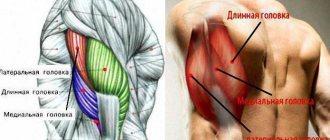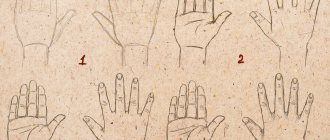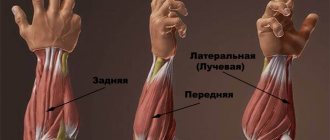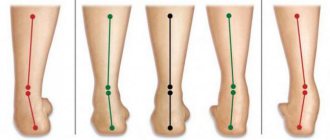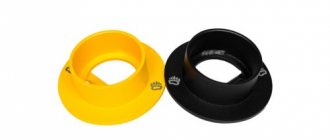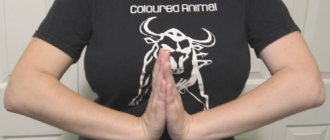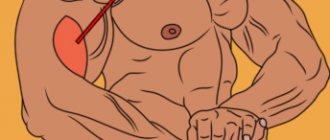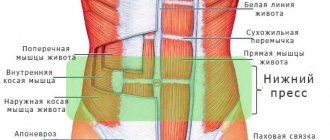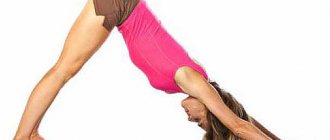Place in the ranking of authors: out of competition
(become an author)
Date:
2012-05-29
Views:
303,378
Rating:
5.0
| Article medals: |
Why medals are given to articles:
| more than 100 thousand views | |
| Bronze medal: | |
| 1. The article is in the TOP 100 2. The article has more than 3. The article has more than 100 | |
| Silver medal: | |
| 1. The article is in the TOP 50 2. The article has more than 3. The article has more than 500 | |
| Gold medal: | |
| 1. The article is in the TOP 10 2. The article has more than 1 3. The article has more than 1,000 | |
Arms hurt from elbow to hand, causes
a man puts a tight bandage on his sore wrist.
To determine the causes of pain in the arms from the elbow to the hand, analyze the nature of the pain:
- chronic or frequently recurring
- single, occurring after severe physical exertion
In the second case, the reasons will be:
- excessive one-time loads, for example, in the gym, when lifting weights, in the countryside
- unsuccessful movements, for example, a sharp jerk, holding the weight for a long time in the arm bent at the elbow
In the first case, the reasons are more serious:
- Tennis elbow, when tension accumulates in the muscles, ligaments and joints due to heavy physical labor. Even agricultural work in the warm season affects the development of this disease. And office workers, due to prolonged sitting at a computer with their arms bent at the elbows, increase their chances of developing pain in their arms from the elbow to the hand
- fractures and bruises received in the past. Any rupture or tear in the hard and soft tissues of the human body does not pass without a trace.
- inflammatory processes in the joints, for example, arthritis, arthrosis
- diseases in the cervical spine
- coronary heart disease and pre-infarction condition
To correctly diagnose the cause of pain in your hands, you should visit medical specialists and undergo examinations not only of your hands, but of your heart and cervicothoracic spine.
Description of the exercise
You can put your hands on the bench. You can sit on your lap. Whichever is convenient for you. In any case, there is no need to tear your elbows off the stand. Don't chase the scale. This exercise is done at least 10 times. This exercise is especially useful for beginners. Because their forearm muscles tend to lag behind.
1. Grip shoulder-width apart, or slightly narrower. In general, your forearms should be parallel to each other.
2. You can do the same with dumbbells. But I believe that it is less effective with dumbbells. Since the brushes begin to move not only up and down, but also to the sides. And this reduces the effectiveness of the exercise.
3. Whether you place your hands on the bench or on your hips is up to you. There are no fundamental differences. I personally put it on my hips.
4. Try to linger a little at the top point.
5. The elbows are motionless during the entire exercise. That is, do not tear them away from the support.
6. In this exercise, the weight is usually half that of the wrist curl. For beginners this is usually a 10 kg bar.
Wrist extensions are part of a set of basic exercises for developing forearm mass, but this exercise does not help develop grip strength. However, even powerlifters are recommended to use it, since exercises for the forearms also develop the wrist joint, which ensures comfortable bench presses. Wrist extensions can be performed with a barbell or dumbbells and can be performed standing, seated, or on a Scott bench. It is best to include exercises for training your forearms in your arm training, or dedicate a separate workout for this; you can include additional optional training in your training program for such body parts as the forearm, triceps, neck and abs.
Why do my hands hurt in the morning?
Your hand hurts in the morning, the girl is stretching it.
Morning dull pain and stiffness in the movements of fingers and hands in general can signal you about the development of diseases such as:
- chronic arthritis
- rheumatoid arthritis
The causative agent of chronic arthritis is an infection that either directly entered the joint or “swimmed” through the bloodstream.
Gradually, inflammation increases in the joint of the hand, which is replaced by deformation and destruction of the joint.
The second disease is autoimmune in nature and affects middle-aged people 25-45 years old, as well as young people during puberty.
Due to a malfunction, the human immune system begins to perceive healthy cells of the body as foreign and joins in the fight against the latter. This is how educational processes arise in the joints, which lead to their deformation and difficulty in performing daily work.
Rheumatoid arthritis begins in the joints of the fingers of the extremities and gradually rises to the level of the cervical spine. Along the way, it destroys bone tissue and tendons.
Its characteristic feature is a dull pain, a feeling of stiffness and tightness in the fingers and hands, which disappear a few hours after waking up.
The disease is classified as incurable; it can be slowed down by:
- anti-inflammatory therapy
- surgical intervention
Hand bones
The hand has three sections: wrist, metacarpus and fingers.
Carpal bones
The eight small bones of the wrist have an irregular shape. They are located in two rows.
The proximal row consists of the following bones, if you go from the thumb to the fifth finger: scaphoid, lunate, triquetrum and pisiform. The distal row also consists of four bones: polygonal, trapezoid, capitate and hamate, which with its hook faces the palmar side of the hand. The proximal row of carpal bones forms an articular surface convex towards the radius. The distal row is connected to the proximal row using an irregularly shaped joint. The bones of the wrist lie in different planes and form a groove (carpal groove) on the palmar surface and a bulge on the back. The groove of the wrist contains the tendons of the finger flexor muscles. Its inner edge is limited by the pisiform bone and the hook of the hamate bone, which are easily palpable; the outer edge is composed of two bones - the scaphoid and the polygonal.
Metacarpal bones
The metacarpus consists of five tubular metacarpal bones.
The metacarpal bone of the first finger is shorter than the others, but is distinguished by its massiveness. The longest is the second metacarpal bone. The following bones towards the ulnar edge of the hand decrease in length. Each metacarpal bone has a base, a body and a head. The bases of the metacarpal bones articulate with the bones of the wrist. The bases of the first and fifth metacarpal bones have saddle-shaped articular surfaces, and the rest have flat articular surfaces. The heads of the metacarpal bones have a hemispherical articular surface and articulate with the proximal phalanges of the fingers. Bones of the fingers
Each finger consists of three phalanges: proximal, middle and distal. The exception is the first finger, which has only two phalanges - proximal and distal. The proximal phalanges are the longest, the distal ones are the shortest. Each phalanx has a middle part - a body and two ends - proximal and distal. At the proximal end is the base of the phalanx, and at the distal end is the head of the phalanx. At each end of the phalanx there are articular surfaces for articulation with adjacent bones.
Sesamoid bones of the hand
In addition to these bones, the hand also has sesamoid bones, which are located in the thickness of the tendons between the metacarpal bone of the thumb and its proximal phalanx. There are also unstable sesamoid bones between the metacarpal bone and the proximal phalanx of the second and fifth fingers. Sesamoid bones are usually located on the palmar surface, but are occasionally found on the dorsal surface. The sesamoid bones also include the pisiform bone. All sesamoid bones, as well as all processes of bones, increase the leverage of the muscles that are attached to them.
Ligamentous apparatus of the hand
Wrist joint
The formation of this joint involves the radius and bones of the proximal row of the wrist: scaphoid, lunate and triquetrum. The ulna does not reach the surface of the radiocarpal joint (it is “supplemented” by the articular disc). Thus, in the formation of the elbow joint, the ulna plays the largest role of the two bones of the forearm, and the radius plays the largest role in the formation of the radiocarpal joint. In the radiocarpal joint, which has an elliptical shape, flexion and extension, adduction and abduction of the hand are possible. Pronation and supination of the hand occur together with the same movements of the bones of the forearm. A small passive rotational movement is also possible in the radiocarpal joint (10-12°), but this occurs due to the elasticity of the articular cartilage. The position of the gap of the radiocarpal joint is determined from the dorsal surface, where it is easily detected through the soft tissues; in addition, its position is determined from the radial and ulnar sides. On the radial side, in the area of the inferior radial fossa, you can palpate the gap between the lateral styloid process and the scaphoid bone. On the ulnar side, a depression is felt between the head of the ulna and the triquetral bone, corresponding to the ulnar portion of the cavity of the radiocarpal joint. Movements in the radiocarpal joint are closely related to movements in the midcarpal joint, which is located between the proximal and distal rows of carpal bones. This joint has a complex, irregularly shaped surface. The total range of mobility when flexing the wrist reaches 85°, and when extending it is also approximately 85°. Adduction of the hand in these joints is possible by 40°, and abduction by 20°. In addition, circular movement (circumduction) is possible in the radiocarpal joint. The radiocarpal and midcarpal joints are strengthened by numerous ligaments. The ligamentous apparatus of the hand is very complex. The ligaments are located on the palmar, dorsal, medial and lateral surfaces of the wrist, as well as between the individual bones of the wrist. The most important collateral ligaments of the wrist are the radial and ulnar ligaments. The first goes from the lateral styloid process to the scaphoid bone, the second - from the medial styloid process to the triquetral bone. Between the bony elevations on the radial and ulnar sides of the palmar surface of the hand there is a ligament, the flexor retinaculum. It is not directly related to the joints of the hand, but is, in fact, a thickening of the fascia. Throwing over the carpal groove, it turns it into the carpal tunnel, where the flexor tendons of the fingers and the median nerve pass.
Carpometacarpal joints of the hand
They are connections of the distal row of carpal bones with the bases of the metacarpal bones. These joints, with the exception of the carpometacarpal joint of the thumb, are flat and inactive. The range of movements in them does not exceed 5-10°. Mobility in these joints, as well as between the bones of the wrist, is sharply limited by well-developed ligaments. The ligaments located on the palmar surface of the hand make up a strong palmar ligamentous apparatus. It connects the carpal bones to each other, as well as to the metacarpal bones. On the hand you can distinguish ligaments that run arcuate, radial and transverse. The central bone of the ligamentous apparatus is the capitate, to which more ligaments are attached than to any other bone of the wrist. The dorsal ligaments of the hand are much less developed than the palmar ligaments. They connect the bones of the wrist to each other, making up thickening capsules covering the joints between these bones. In addition to the palmar and dorsal ligaments, the second row of carpal bones also has interosseous ligaments. Due to the fact that the bones of the distal row of the wrist and the four (II-V) bones of the metacarpus are inactive relative to each other and are firmly connected into a single formation that makes up the central bone core of the hand, they are designated as the solid base of the hand. The carpometacarpal joint of the thumb is formed by the polygonal bone and the base of the first metacarpal bone. The articular surfaces are saddle-shaped. The following movements are possible in the joint: adduction and abduction, opposition (opposition) and reverse movement (reposition), as well as circular movement (circumduction). Due to the opposition of the thumb to all other fingers, the scope of grasping movements of the hand increases significantly. The amount of mobility in the carpometacarpal joint of the thumb is 45-60° during abduction and adduction and 35-40° during opposition and reverse movement.
Metacarpophalangeal joints of the hand
Formed by the heads of the metacarpal bones and the bases of the proximal phalanges of the fingers. All these joints have a spherical shape and, accordingly, three mutually perpendicular axes of rotation, around which flexion and extension, adduction and abduction, as well as circular movement (circumduction) occur. Flexion and extension are possible at 90-100°, abduction and adduction - at 45-50°. The metacarpophalangeal joints are strengthened by collateral ligaments located on the sides of them. On the palmar side, the capsules of these joints have additional ligaments called palmar ligaments. Their fibers are intertwined with the fibers of the deep transverse metacarpal ligament, which prevents the heads of the metacarpal bones from diverging to the sides.
Interphalangeal joints of the hand
They have a block-like shape, their axes of rotation run transversely. Flexion and extension are possible around these axes. Their volume in the proximal interphalangeal joints is 110-120°, while in the distal ones it is 80-90°. All interphalangeal joints are strengthened by well-defined collateral ligaments.
Fibrous and synovial sheaths of the tendons of the fingers
The flexor retinaculum and extensor retinaculum ligaments are of great importance for strengthening the position of the muscle tendons passing under them, especially when flexing and extending the hand: the tendons rest on the named ligaments from their inner surface, and the ligaments prevent the tendons from moving away from the bones and withstand significant pressure during strong muscle contractions . The sliding of the tendons of the muscles passing from the forearm to the hand and the reduction of friction are facilitated by special tendon sheaths, which are fibrous or osteo-fibrous canals, inside of which there are synovial sheaths, in some places extending beyond these canals. The largest number of synovial sheaths (6-7) is located under the extensor retinaculum. The formation of the canals involves the ulna and radius bones, which have grooves corresponding to the passage of the muscle tendons, and fibrous bridges that separate one canal from the other, which go from the extensor retinaculum to the bones. The palmar synovial sheaths belong to the flexor tendons of the hand and fingers running in the carpal canal. The tendons of the superficial and deep flexor fingers lie in a common synovial sheath, which extends to the middle of the palm, reaching the distal phalanx of only the fifth finger, and the tendon of the flexor pollicis longus is located in a separate synovial sheath, which passes along with the tendon onto the finger. In the palm area, the tendons of the muscles going to the second, third and fourth fingers are deprived of synovial sheaths for some distance and receive them again on the fingers. Only the tendons leading to the fifth finger have a synovial sheath, which is a continuation of the common synovial sheath for the flexor tendons of the fingers.
Muscles of the hand
On the hand, the muscles are located only on the palmar side. Here they form three groups: the middle one (in the middle section of the palmar surface), the thumb muscle group and the small finger muscle group. The large number of short muscles on the hand is due to the fine differentiation of finger movements.
Middle hand muscle group
Consists of lumbrical muscles that originate from the tendons of the deep flexor digitorum and are attached to the base of the proximal phalanges of the second to fifth fingers; palmar and dorsal interosseous muscles, which are located in the interosseous spaces between the metacarpal bones and are attached to the base of the proximal phalanges of the second to fifth fingers. The function of the muscles of the middle group is that they are involved in flexing the proximal phalanges of these fingers. In addition, the palmar interosseous muscles bring the fingers of the hand towards the middle finger, and the dorsal interosseous muscles spread them apart.
Thumb muscle group
Forms the so-called eminence of the thumb on the hand. They begin on the nearby bones of the wrist and metacarpus. Among them are distinguished: the short muscle that abducts the pollicis, which is attached to its proximal phalanx; flexor pollicis brevis, which attaches to the external sesamoid bone located at the base of the proximal phalanx of the thumb; the opponus pollicis muscle, which goes to the first metacarpal bone; and the adductor pollicis muscle, which attaches to the internal sesamoid bone located at the base of the proximal phalanx of the thumb. The function of these muscles is indicated in the name of each muscle.
Small finger muscle group
Forms an elevation on the inside of the palm. This group includes: palmaris brevis; abductor digiti minimi muscle; flexor little finger brevis and oppons little finger muscle. They arise from the nearby carpal bones and attach to the base of the proximal phalanx of the fifth finger and the fifth metacarpal bone. Their function is determined by the name of the muscles themselves.
Materials used in the article: sportmedicine.ru
Buy handgam How to calm yourself with the help of handgam Unusual properties of handgam Photos of handmade crafts
Why do my hands hurt at night?
the hand hurts at night, the man develops the joint.
Night pain in the hands annoys you due to:
- carpal or carpal tunnel syndrome
- gout attacks
- injuries received the day before as a result of intense physical labor or awkward position of the hands
In the first case, the doctor will diagnose a pinched nerve in the hand joint. The reasons for this phenomenon are:
- hormonal changes in the body, for example, pregnancy, menopause, development of diabetes mellitus
- uncomfortable working posture, for example, at the computer, when your hands hang over the keyboard
Meat-eating disease, or gout, develops due to the accumulation of a specific substance in the joint sacs.
It is dangerous due to the destruction of connective and bone tissue, as well as the formation of growths on the bones, which tear all types of surrounding tissue.
Gout begins with unpleasant pain in the joints of the toes, gradually rising higher in the body. It affects the wrist joint and annoys a person at night with aching, pulling, bursting and throbbing pain.
The third reason for night attacks of pain in the hands includes injuries that you could have received the day before and not given much attention to.
A microtear of a muscle or tendon, a severe bruise or even a crack can deprive anyone of a restful sleep.
Treatment of damage to the extensor tendons of the fingers
In the treatment of injuries to the extensor tendons of the fingers, not only a surgical method is used, but also a conservative one, in contrast to injuries to the flexor tendons. Damage at the level of the fingers can be cured without surgery, but with long-term wearing of a plaster or plastic splint. Damage to the tendon at the level of the metacarpal bones, wrist and forearm, unfortunately, can only be treated surgically. Because the ends of a torn or cut tendon need to be stitched. Your doctor will explain the need and benefits of various treatments for extensor tendon injuries.
Why does my hand hurt when I exercise?
the athlete strains his arm a lot during training.
The hands can also become sore during physical activity. And the reasons for this are:
- osteoarthritis
- tendinitis
- untreated old injuries and injuries in the wrist area
Osteoarthritis weakens the cartilage of the joints and wrist bone. It may also develop due to:
- poorly treated fractures of the hand and fingers
- the presence of a systemic chronic disease, for example, polyarthritis
- disruptions in the body's metabolic processes
In addition to pain, you may hear a crunching sound, see swelling in the area of the affected joint, and in advanced cases, its deformation. You have great difficulty in handling small objects because your hands and fingers refuse to bend and straighten properly.
Tendinitis is localized in the inflamed tendons of the wrist. This disease is of an occupational nature and occurs in athletes, seamstresses, pianists, and loaders.
Tendinitis manifests itself as acute pain and weakness of the arms during exercise on the hands.
You may also hear crunching sounds when you work with your hands.
It is treatable, but returns again when the person resumes his usual activities.
The third cause of pain symptoms in the hands during exercise is untreated injuries. For example, a fracture of the phalanx of a finger, without proper treatment, heals incorrectly and can no longer perform its functions efficiently. The same applies to fractures, cracks and displacements of bones in the wrist area.
Work of muscles and joints
Since the forearm is a very small muscle group, exercises for its development are all isolating in nature. The fact is that if you do not isolate other muscles, they will steal too much load, so the target muscle group will not work. Since the athlete performs wrist extensions, it is not surprising that the extensors located on top of the forearm are trained. These muscles are very important because they are always visible, they form the external massiveness of the arm and forearm in particular. A well-developed extensor can even outwardly neutralize the lag of the biceps, so this exercise is highly recommended for those athletes who have short biceps, as well as those who have it behind.
During extension of the hands, only the wrist joint receives load, but this load is positive, since the barbell or dumbbells do not put pressure on the hand from above, but, on the contrary, pull it down. This work strengthens the joint, making it more powerful, which helps avoid injury in more strenuous exercises. On the other hand, since the joint works alone, it is recommended to perform the exercise at a slow pace, which has a positive effect on both muscle hypertrophy and the condition of the wrist joint. Since the exercise is isolating and is intended to train such a small muscle group, the athlete must strictly adhere to the correct technique for performing the exercise.
My hand hurts when I bend it, what should I do?
a girl is plagued by pain in her hand while bending
. Since pain in the hands most often appears during vigorous activity, you should:
- stop and bend/extend the fingers and hands of both hands
- Press your fingers on the place that hurts. If the pain does not subside, or even intensifies, immediately go to the emergency room and see a surgeon. You may have a fracture, torn ligament, or serious tendon damage
- rub your palms and the sore spot without applying strong pressure
- if pain symptoms in the wrists recur, then do not delay a visit to one of the doctors - a surgeon, a traumatologist
Remember that self-medication in the form of rubbing ointments and applying compresses may be useless if you have serious pathology in the metacarpal area.
No herbs can restore broken bones, torn ligaments and tendons, deteriorating cartilage tissue, or release a pinched nerve.
Flexion and extension technique
Take your starting position. To do this, you need to stand or sit so that your elbows are supported, the angle at the elbow joints is 90 degrees, and your hands can move freely. You can sit astride a bench and place your forearms on the edge, kneel in front of a bedside table and also rest your forearms on it, or simply sit and rest your hands on your hips. The main condition is the immobility of the shoulder and forearm during the exercise.
To perform barbell curls:
- Take the bar with an underhand grip, placing your hands slightly narrower than your shoulders. Take your starting position. If you work out in the gym, sit on a bench and place your forearms on it so that your hands hang down. To make it more comfortable, you can first sit correctly and then ask your partner to hand you the barbell.
- From the lowest position, bend your arms at the wrists.
The exercise is performed for 15–20 repetitions, in 3–4 approaches. You can do it to failure.
To perform extensions:
- Without changing the starting position, change your grip. You should now hold the weight with an overhand grip. The weight may need to be reduced a little, since straightening your arms is more difficult than bending them.
- Raise your hands up as far as the flexibility of your joints allows, and lower them to the starting position.
The number of approaches and repetitions is similar to curls. That is, do it 15–20 times or until failure in 3–4 approaches.
My hands hurt and swell, what should I do?
a man’s one arm is swollen, and the other is healthy.
Before answering this question, let’s consider the possible causes of this phenomenon:
- severe bruise of a finger or arm, fracture, injury
- prolonged physical activity on the hands, especially in the warm season in rural areas
- the presence of serious diseases of the joints, spine, internal organs
In the first case , be sure to apply ice to the sore spot and go to the doctor for an examination. Remember that ignoring injuries is the path to the development of pathological diseases of connective tissues, deformation and difficulty in the functioning of the limbs.
In the second case, only drawing up and following the correct daily routine will help you, where time is allotted for proper rest after work. Only a reasonable combination of them will prolong your well-being and health.
In the third option, pain and swelling of the hands recur regularly and ice is not enough. If these symptoms do not go away within two days, then immediately go to the clinic.
Visit a doctor, undergo an X-ray, MRI, etc., to accurately determine the disease that causes unpleasant pain and swelling of the hands.
Treatment methods for various extensor tendon injuries
Hammer finger
If the tendon injury at the level of the distal interphalangeal joint is closed, conservative treatment is possible, namely splinting for 5 weeks. Sometimes, for a faster recovery, the “extensor tendon suture” operation is performed at the level of the fingers. A splint is used after surgery to maintain the finger in an extended position until the tendon heals (approximately 3 weeks). The splint must remain on the finger at all times. Removing the splint prematurely can lead to rupture of the unformed tendon scar and the tip of the finger (nail phalanx) will return to the flexion position. In this case, the splinting is performed again. The doctor should monitor you during treatment to determine whether the splint is secure enough, whether it has broken, and will remove it at the appropriate time.
Deformation boutonniere
Treatment involves splinting the middle joint in a straight position until the tendon injury is completely healed. Sometimes, stitches are needed when the tendons have been cut and even if the tendon ruptures. If the injury is not treated, or if the splint is not worn correctly, the finger can quickly become even more crooked and finally freeze in that position. Be sure to follow your doctor's instructions and wear the splint for at least four to eight weeks. Your doctor will tell you when you can stop wearing the splint.
Wounds on the back of the hand and wrist with damage to the extensor tendons
Injury (damage) to the extensor tendons at the level of the metacarpal bones, wrist or forearm in any case requires surgical treatment, because Due to the reflex contraction of the muscles, they pull the tendons along with them and a significant divergence of the damaged ends occurs.
The operation is performed under conduction or local anesthesia. The damaged ends of the tendon are sutured. Careful hemostasis (stopping bleeding) is performed and the wound is sutured. A plaster splint or plastic splint is applied as mandatory postoperative immobilization to avoid rupture of the sutured tendon. The operation is performed on an outpatient basis and the patient will be able to go home.
Why does my hand go numb and hurt?
a girl kneads a numb hand.
In addition to pain, your hands may become numb, that is, you lose sensitivity in this part of the limb.
The reasons may be:
- problems with blood circulation. Due to the thinness of the vessels and the presence of vegetative-vascular dystonia, the flow of blood and oxygen is difficult in the hands
- disturbances in the functioning of the nervous system, which manifest themselves in the form of vascular spasms and cyanosis of the fingers. This is typical, for example, with arthritis
- Uncomfortable sleeping position, pillow or bed cause irritability and fatigue that accumulate, as well as numbness in the limbs
- lack of B vitamins
- pinching and hernia of the vertebrae of the cervical and thoracic spine, for example, due to hernia, osteochondrosis
- tunnel syndrome, which has become the scourge of the modern IT industry and computer scientists. Due to prolonged monotonous loads on the fingers and hands, as well as an uncomfortable posture, the median nerve is pinched and the ability of the hands to perform their functions normally is reduced.
- severe bruise of fingers or hand received during physical labor
Why does my child's hand hurt?
The baby is crying because of pain in the arm.
Children move and play a lot, so they are not immune from bruises and injuries. Poor movements, heavy lifting and monotonous long-term activities for the hands, such as drawing and playing the piano, cause pain in the hands.
On the other hand, take into account such factors as heredity. If one of the parents was diagnosed with osteoarthritis, then this disease can manifest itself in the child.
The cause of osteoarthritis is arthrosis, or in other words, too rapid aging and destruction of cartilage tissue in the joints.
The child complains about:
- hand pain even when pressing on the joint area of the wrist
- limited mobility
What happens as a result of an extensor tendon injury?
With a rupture of the extensor tendon, there are much fewer consequences and impairments in hand function than with damage to the finger flexor tendons. If the damage is localized at the level of the fingers, then the upper end of the tendon does not “run away” (thanks to the jumpers between the tendons just above the heads of the metacarpal bones), but remains in place and grows into the surrounding tissues in 3 weeks. Such damage slightly impairs the extension of the finger, by about 20-30 degrees. The function of the hand is almost unaffected. Surgery is required to achieve full extension. If the damage to the extensor tendon is localized at the level of the metacarpal bones, wrist or forearm, then due to reflexive contraction of the muscles they pull the tendons and a significant divergence of the ends of the tendon occurs. Many factors can influence the severity of an injury, including fractures, infections, medical illnesses, and individual differences.
Hammer finger
Hammer finger deformity is shown in the figure. It is a bent nail phalanx at the proximal interphalangeal joint. Typically, the cause of such damage is injury from a sharp object, a fall on a straightened finger, or a direct blow. If this damage is not treated, the nail phalanx will not straighten on its own. But the finger will not completely lose its function, because The central bundle of the extensor tendon is attached to the middle phalanx of the finger.
This deformity is caused by the fact that the flexor tendons are constantly toned and strive to bend the finger without counteraction from the extensor.
It is not uncommon for the injury to involve separation of part of the distal phalanx.
Deformation boutonniere
It is a bent finger at the proximal interphalangeal joint. As a rule, the cause of such damage is injury from a sharp object, a circular saw. If this injury is not treated, the finger will not fully straighten on its own. But it will not completely lose its function, because... On the sides of the central bundle of the extensor tendon there are lateral ones and they will take on part of the extensor function. The flexor tendons will tend to bend it without the extensor counteracting it.
Wounds on the back of the hand and wrist with damage to the extensor tendons
It is a fully bent finger in all joints. The cause of such damage to the extensor tendon of the digitorum is usually an injury with a sharp object, a circular saw, at the level of the metacarpal bones, wrist or forearm. If this injury is left untreated, there will be significant loss of extensor function in one or more fingers. Minor extension movements (20-30 degrees) will remain due to the bridges between the extensor tendons at the level of the metacarpal heads.
Sore hands, folk remedies
a girl kneads another person's sore hand.
To relieve joint pain, traditional healers and naturopathic doctors know many medicinal herbs and their infusions.
If you know for sure that pain in the wrist is not a symptom of a broken or cracked bone, ruptured ligament, or tissue necrosis, then prepare yourself a medicine for treatment from the gifts of nature.
Recipe 1
lilac helps get rid of pain in hands
- Place fresh lilac flowers in a dark container, filling it halfway
- Top up with vodka and cover with a lid.
- Store the container in a dark place for two weeks, remembering to shake it daily
- Take a tablespoon one hour before meals
- The course of treatment is at least a month
- Instead of lilac, use walnut shells and take according to the above scheme
Recipe 2
Dandelion root and its decoction are a cure for pain in the hands
- In summer, dig up dandelion roots, wash them, dry them and cut them into pieces about a centimeter long.
- Place them in a hot oven until they turn brown.
- Grind dandelion roots in a coffee grinder
- Pour a glass of boiling water over a measuring unit of the finished raw material and leave to steep for a quarter of an hour.
- Drink every day an hour after each meal for a month
Recipe 3
fly agaric will help get rid of pain in the hands
- Fill a glass container one third with fly agaric caps, fill the rest of the space with vodka.
- Close the lid tightly and leave to infuse in a cool, dark place for two weeks.
- Shake the container with the alcohol solution of fly agarics daily
- Rub the sore spots with the tincture at night and wrap them in thick cotton gloves.
- Duration of treatment - 30 days
A powerful remedy for restoring joints and tissues around them is marsh cinquefoil. Read more about its benefits and methods of use here
Sore hands and fingers, treatment of hand joints
finger massage to relieve pain
As we discussed above, there are a large number of diseases of the hands - from bruises to tissue necrosis due to serious damage.
Therefore, there are many methods for treating pain symptoms in the wrist area, palms and fingers:
- alternating work and rest schedules
- change of activity, for example, after lifting heavy objects, do something that does not require excessive strain on the upper limbs
- massage and compresses with medicinal herbs and pharmaceuticals
- manual therapy
- physical therapy and taking vitamins
- ointments, creams and injections
- taking painkillers and anti-inflammatory drugs, specific hormones
- surgical intervention
- treatment of the cause of pain, for example, cardiovascular diseases, osteochondrosis
In any case, treatment of pain in the hand joint should be preceded by consultation with specialists - a traumatologist, surgeon, neurologist. They, in turn, will select a regimen to eliminate pain, treat its cause and restore mobility of the affected area of the arm.
Conservative treatment of hand tendinitis
Inflammation of the tendons of the hand is highly treatable. Basic therapy consists of wrist immobilization, NSAIDs (nonsteroidal anti-inflammatory drugs) and a course of physical therapy.
To immobilize the wrist, use a tight elastic bandage or orthosis. Immobilization lasts from 2 to 4 weeks depending on the degree of tendon damage. If the underlying cause of hand tendonitis is infection or rheumatic disease, the wrist should not be immobilized.
Drug therapy consists of taking NSAIDs, for example, Diclofenac, Nimesil, Viprosal, Ketoprofen. If NSAIDs do not reduce the inflammatory process, you can use hormone-containing drugs in the form of injections, which are injected directly into the site of inflammation.
Drug treatment of hand tendonitis is complemented by physiotherapeutic procedures: electrophoresis, shock wave therapy, magnetotherapy, as well as therapeutic massage and exercise therapy.
Treatment of arthritis and arthrosis of the hands
Ultrasound examination of the patient's hand in the clinic
Arthritis of the hands occurs due to infection in the joints of the fingers and/or hands.
It quickly takes over space, killing healthy cells of cartilage, bones, tendons and joints.
Over time, without proper treatment, arthritis:
- severely deforms the structure of the hand
- causes limited movement and fluid accumulation in the joint
In the arsenal of methods for treating arthritis, doctors have:
- medicinal - injections, tablets, compresses of non-steroidal elements, antibiotics, hormones
- folk remedies for pain relief
- physiotherapy, e.g. electrophoresis, magnetic therapy
- massage
Arthrosis affects the joints of the fingers and is extremely rarely diagnosed in the wrist.
In the early stages of development, it causes pain at night; in later stages, swelling and redness of the skin are added after intense physical activity.
This disease leads to:
- deformation and destruction of cartilage tissue
- the formation of growths in the form of nodules that limit the extension functions of the hands
Arthrosis can be treated in a comprehensive manner:
- medications that relieve pain and stop destruction processes
- traditional medicine
- therapeutic exercises
- massage
For example, at home you can help reduce the manifestations of arthrosis with the help of the following products:
- honey and salt - mix them in equal proportions and apply to sore spots at night. Be sure to wrap your hand warmly
- pharmaceutical clay - it is good as a mask for a sore joint
- cabbage leaf
- grated potatoes, namely the green area, which is rich in poisons. They act on the painful area as antispasmodics
- chopped green onions, white clay and low-fat kefir
Wrist extensions - diagram
1) Hold a barbell or dumbbells in your hands, and then rest the lower surface of your forearm on a Scott bench if you are doing the exercise while standing, or lean on your knees if you are doing the exercise while sitting. 2) You need to keep your hands slightly wider than your shoulders so that it is comfortable to follow the trajectory of the amplitude of movement. 3) The exercise begins with raising the hands as high as possible, after which the athlete pauses for 1-2 seconds at the point of peak contraction of the wrist extensors. 4) After the athlete has raised his hands as high as possible, they should be lowered down as much as possible to stretch the muscles, after which the exercise is repeated from the beginning.
Wrist extensions - notes
1) Despite the fact that the exercise is isolating, you need to breathe correctly, exhaling with effort and inhaling in the negative phase. 2) It is necessary to hold the barbell or dumbbells with a closed grip, which both ensures better muscle contraction and eliminates the likelihood of dropping the barbell. 3) Wrist extensions are best performed in the range of 15-20 repetitions, since during this time you will have time to use up all the creatine phosphate, which will force the body to use glycogen as energy, which is exactly what we need. 4) You need to lower your hands down slower than lift them up, which ensures weight control throughout the entire range of motion.
Anatomy
The forearm is a small muscle group, but since the forearm performs so many functions, there are a lot of muscles concentrated in the forearm. That is why there are quite a lot of exercises for training the forearm, each of which trains individual muscles. Wrist extensions, of course. The extensors located on top of the arm are trained, so the exercise is included in the arsenal of forearms that are required for training. In general, the hand can be flexed, extended, supinated and pronated; accordingly, you can train the forearm by performing one of these four movements.
To summarize , we can say that wrist extensions are an effective exercise, but they can and should be used only by those athletes who have lagging forearm or those. who needs to level out the genetic lag of the biceps. In any case, the athlete should already be pumped up enough to determine that this or that part of the body is lagging behind. During the first period of training, it is better not to touch the forearm, since, most likely, it will already receive sufficient load during the performance of basic exercises, such as the bench press, deadlift, squats with a barbell and many others.
